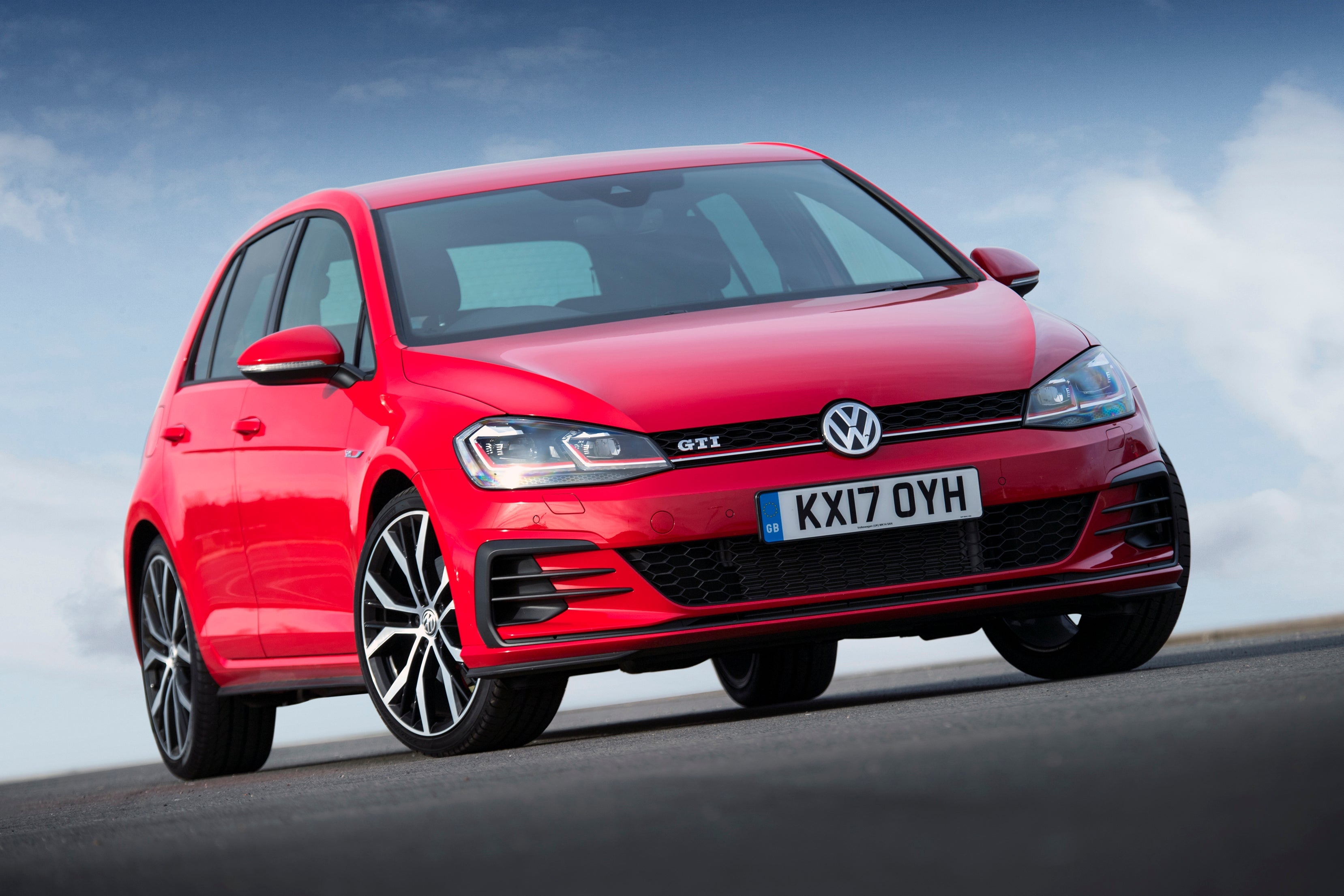Volkswagen Golf GTI (2014-2019) Review
Written by Andrew Brady
Quick overview
Pros
- Strong performance
- Brilliant all-rounder
- Balanced handling
Cons
- Pricier than many rivals
- Too strait-laced for some
- Fastest are limited editions only
Overall verdict on the Volkswagen Golf GTI
"While some manufacturers may have pinched the GTI badge for sporty versions of their hatchbacks, the fact is that there is only one true claimant to the name and that’s the Volkswagen Golf GTI. The seventh generation Golf GTI follows the now familiar formula with a turbocharged 2.0 TSI petrol engine, with power steadily increased during its lifetime, a front-wheel drive layout and, we're pleased to say, those much loved checker cloth seats."
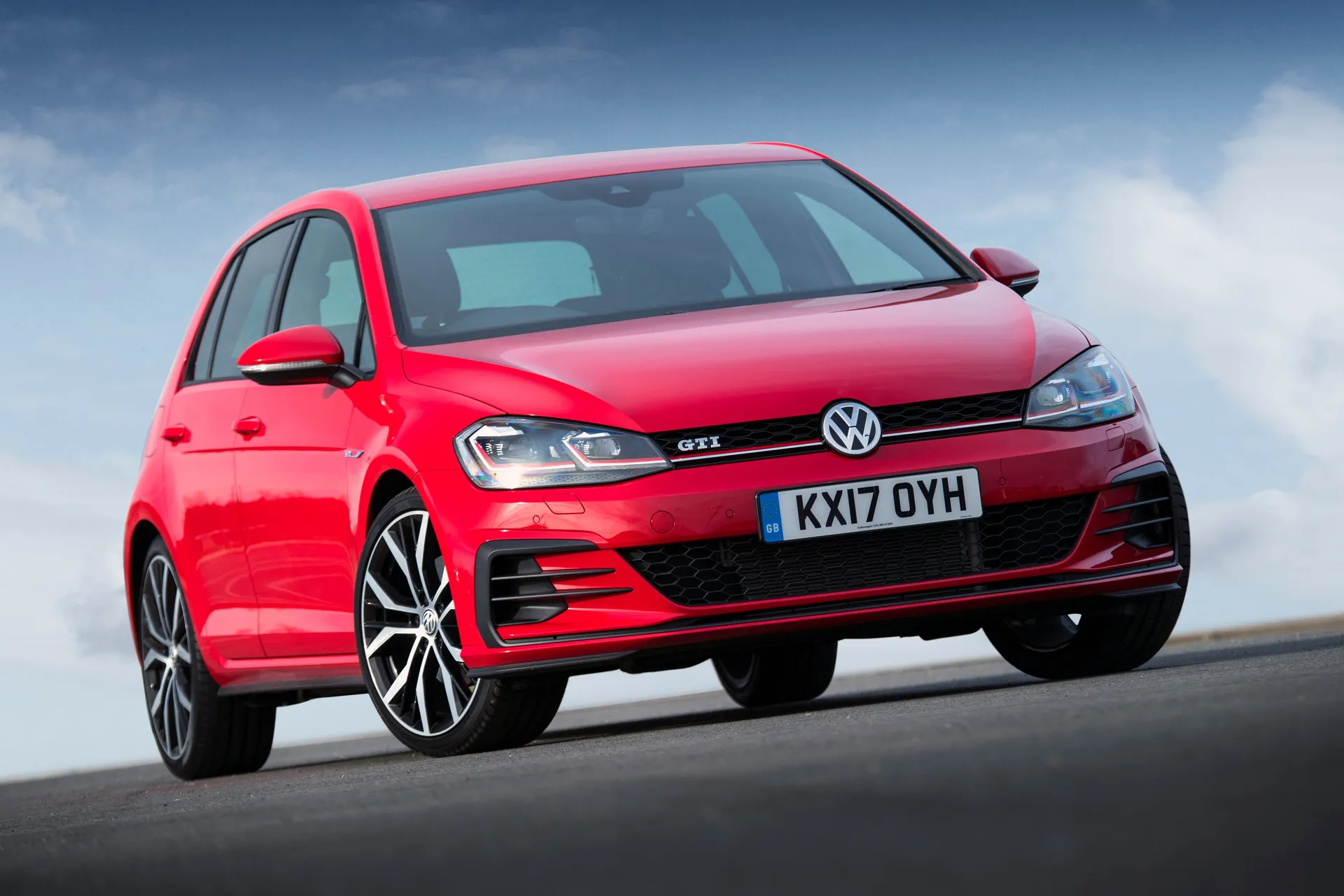
Of course, it's a very different car from the original 1976 Golf GTI, but it's great to see this hot hatch survived the doldrums of the Mk4 from the late 1990s when there were some frankly terrible versions, the worst of which used a 2.0-litre engine with just 115PS. Not what you'd call fast.
Fortunately, those days are long gone. The fightback started with the fifth-generation model that set the template for what we have now and the Golf GTI is once again a bona fide performance machine. It looks the part too. The sharp lines of the Volkswagen Golf hatchback lend themselves perfectly to the GTI and it sits lower with those lovely gloss 18-inch alloys now a GTI trademark bit of design.
There are plenty of nods to the past with the red stripe across the grille that now continues across the headlights which are xenon as standard. At the back there's a tailgate spoiler and dual exhausts giving it a purposeful but understated look. It's the antithesis of the brash Honda Civic Type R.
Under the bonnet, the Golf GTI in its seventh outing has had its power output steadily improved from launch in 2013. Back then, it was offered with 220PS as standard or you could upgrade to the Performance model with 230PS. A limited edition Clubsport model arrived in 2016 with up to 265PS on tap, while the standard GTI grew to 245PS.
The final fling for this Golf GTI was the TCR, which stand for Touring Car Racing, and has 290PS. That bridges the gap between the GTI and Volkswagen Golf R, so it tells you where the TCR’s performance lies with 0-62mph in 5.6 seconds but still with front-wheel drive rather than the R’s all-wheel drive set-up.
The interior of the GTI combines the high quality of the rest of Golf range with some nice touches including the checked cloth seats, red stitching on the lovely flat-bottomed steering wheel and of course the golf-ball style gear lever. It feels special from behind the wheel with superb fit and finish and a perfect driving position. Those sports seats provide excellent side and under thigh support too.
As an all-round hot hatch, the Golf GTI is easily the best on the market. Sure, rival cars may have more power or be quicker accelerating in a straight line, but nothing can match the superb ability and combination of power and finesse that the GTI offers. It's a car that's going to tick a lot of hot hatch buyers’ boxes.
Looking for the newer Volkswagen Golf GTI? You'll need our VW Golf GTI review.
Is the Volkswagen Golf GTI right for you?
It’s hard to think of a hot hatch buyer for whom the Volkswagen Golf GTI isn’t the right car. It’s such a brilliant all-rounder that it works in almost every situation. The standard model can hit 62mph from rest in 6.2 seconds as this has 245PS in Performance spec as the last of the line. That’s 0.2 seconds better than the 230PS version that was the mainstay of the range until the seventh-generation GTI faced replacement by the new eighth gen model in 2020.
Or, you could go for the TCR model with its 290PS that knocks off 0-62mph in just 5.6 seconds to be quicker than the Honda Civic Type R. Even so, this model is still a more civilised machine than the Honda, which is perhaps where the divisions show between the Golf GTI and its rivals.
Some may find the Golf just too polished in the way it drives, rides and sounds. It’s not the rawest hot hatch experience, so there will those who want something more immediately sporting in its style and manner. However, the Golf GTI is a car that appeals from the start and grows on you in every way as time passes thanks to its very deep-seated talents.
What's the best Volkswagen Golf GTI model/engine to choose?
There’s certainly plenty of scope within the Volkswagen Golf GTI range to pick the right car for you. From the early seventh-generation models with 220PS, though the 230PS versions and final 245PS iteration, each goes well and is an exemplar of deft, agile handling. They also ride well and are refined when you need the GTI simply to be a good small hatch.
Then there are the more rapid models in the shape of the Clubsport and TCR. These rarer beasts are more focused and won’t appeal to everyone, and you will have to hunt down the desirable and rare Clubsport.
Where the GTI works best is in its standard form. With 230PS, the GTI is plenty quick, offers three- or five-door practicality, and you have a choice of manual or automatic gearboxes. We’d even stick with the standard cloth seats for the iconic GTI check pattern that looks so good and underlines this car’s long heritage.
What other cars are similar to the Volkswagen Golf GTI?
The Volkswagen Golf GTI’s main threats come from some very talented contenders. They are the Ford Focus ST, Honda Civic Type R and Renault Megane R.S. All three rapid and offer five-door hatch versatility. The Honda is the rawest of the bunch and the Renault the most refined.
That leaves the Ford Focus ST as the nearest rival to the Golf and the ST is quick, fun and well made, albeit with a slightly boring cabin feel. You could also look at the Cupra Leon from within Volkswagen’s own extended family for something with the same pace but slightly sportier outlook. One not as obvious rival is the superb Hyundai i30N, one of our favourite hot hatches.
Comfort and design: Volkswagen Golf GTI interior
"The GTI takes the standard Volkswagen Golf interior, which is already pretty much spot on, and adds some neat styling extras. There are plenty of nods to GTI history with a tartan finish on the seats and the iconic golf ball gear lever. It helps lift the interior of the GTI above the ordinary as does the red stitching on the steering wheel and leather gear lever surround."
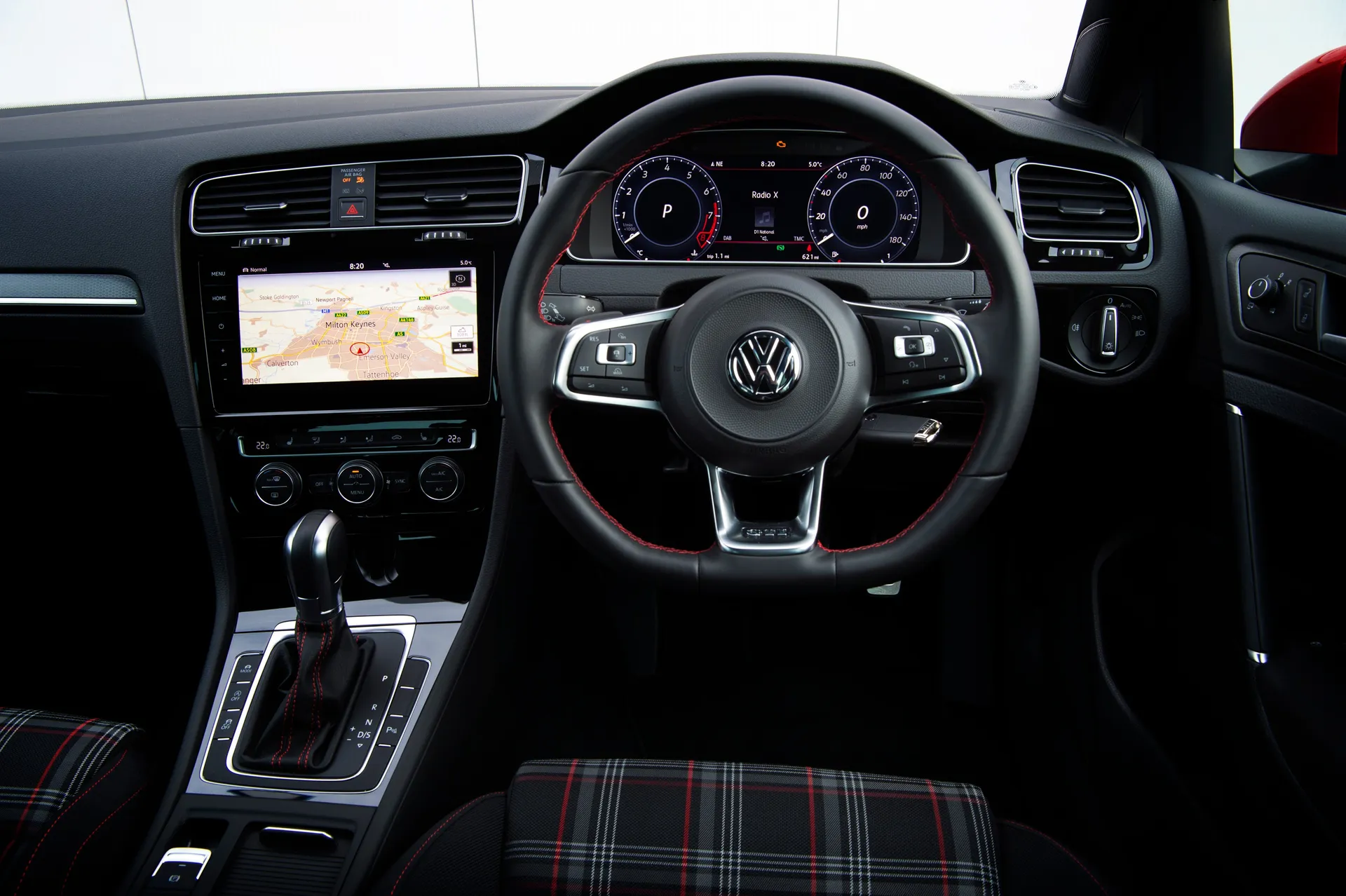
The flat-bottomed steering wheel may not be to everyone's taste, but again it adds that extra touch to the interior appearance and the chunky metal inserts in the steering wheel along with alloy pedals reinforce the Volkswagen quality feel that buyers expect of this brand.
The driving position is spot on thanks to lots of adjustment in the seat, particularly for height, and in the steering wheel that moves for depth and angle. It means even taller drivers will be able to feel low down behind the wheel, allowing the interior to feel like it's wrapped around you. Even so, there’s still good vision in every direction and the Golf suffers less from a blind spot due to the rear pillars than other hatches in this sector.
As you'd expect there's a solid and well-engineered feel to everything, from the reassuring thud of the doors to the slick action of the gear shift. It's an interior that works with real precision. Volkswagen has stuck with traditional analogue instrument dials rather than any fancy digital displays in the seventh-generation GTI, but the trip computer between the main dials has all your key information and includes a digital speedo display.
Quality and finish
Volkswagen are past-masters at making car interiors that feel more solid and substantial than their oppositions and this Golf GTI is no exception. There is the sense it has been carved out of a single piece of GTI-anium such is the feeling of strength to the way the doors shut, the switches operate and all of the materials feel.
This impression is furthered by the simple layout of the Golf GTI’s dash and the consistent, accurate panel gaps. It means there are not rattles or buzzes from the cabin as you drive, which adds to the idea the Golf GTI is a car from the class above the usual hot hatch machinery that makes up its rivals.
There are some parts of the cabin where the plastics are no better or worse than you’ll find in a Ford or Renault or Honda, but Volkswagen has a knack of disguising them well. It also has the skill to make all of the controls work with just the right weight and intuitive on-off click-a-bility to leave you happy and satisfied.
Infotainment: Touchscreen, USB, nav and stereo in the Volkswagen Golf GTI
The Volkswagen Golf GTI range comes with an 8-inch colour touchscreen that will be immediately familiar to anyone who has set foot inside a recent Volkswagen Group product. While it may not be unique to the GTI, its ease of use is reassuring and Volkswagen makes sure of this with shortcut buttons for all of the major functions. There are also clear rotary dials to adjust the stereo volume and another for scrolling through the onscreen menus.
The screen itself has good resolution and, while not placed as high in the dash as some more recent arrivals in the hot hatch sector, it’s easy to see and read. With Apple CarPlay and Android Auto supplied as standard, it’s easy to hook up your smartphone and access its apps through the car.
The later 245PS GTI Performance model also has a 12.3-inch Active Info Display in place of the usual analogue main dials. It can be configured in a variety of ways to suit the driver and work with the car’s various safety systems to show if any danger is looming. Good as this is, we still like the look of the more traditional dials.
Space and practicality: Volkswagen Golf GTI boot space
In keeping with its reputation and appeal as the hot hatch you can use as a family car, the Volkswagen Golf GTI is one of the most accommodating when it comes to people and luggage. You can the GTI in three- and five-door forms and both offer the same commodious interior dimensions.
With the three-door, there is the obvious small drawback of access to the rear seats. For some, this will be a sacrifice worth having for a car that is more sporting in its owner’s eyes. We reckon the five-door is just as handsome, so it’s easier to use entry and exit to the rear quarters makes it our preferred choice.
Choose the three-door and there’s a big gap created when the front seats are slid forward, so even adults can step into the rear of the GTI without any need for gymnastics. Take the five-door and there’s a broad opening that makes it a doddle to load in young children and their car seats.
Space in the back of the Golf GTI is among the best in the hot hatch class. Two adults can fit back here with room to spare for shoulders, knees and heads. You can even fit in a third rear passenger when required and not have to listen to any complaints on short to medium journeys. The centre seat cushions are flat and the base is not excessively padded or raised. Fold down the centre armrest and it provides a pair of cupholders. There are also reasonable door pockets for additional storage.
All rear passengers in the Golf GTI get a three-point seat belt and there are easy to get at Isofix kiddy chair mounts in the two outer pews.
Head to the back of the Golf GTI and both the three- and five-door models offer one of the biggest boots in the class. At 380-litres, it’s the exact same as lesser models in the seventh-generation Golf line-up and bigger than the faster Golf R’s.
Fold the 60-40 split and tip rear seats and the Golf GTI has up to 1270-litres of cargo carrying capacity. Just as importantly, the seats fold to leave a completely flat load bed, which is easy to slide longer items on to, unlike some of the Volkswagen’s rivals.
Handling and ride quality: What is the Volkswagen Golf GTI like to drive?
"The Volkswagen Golf GTI is superbly balanced with wonderfully direct steering and flows through corners beautifully. It's not a car you need to be aggressive with, so you can drive it smoothly yet quickly and still enjoy yourself."
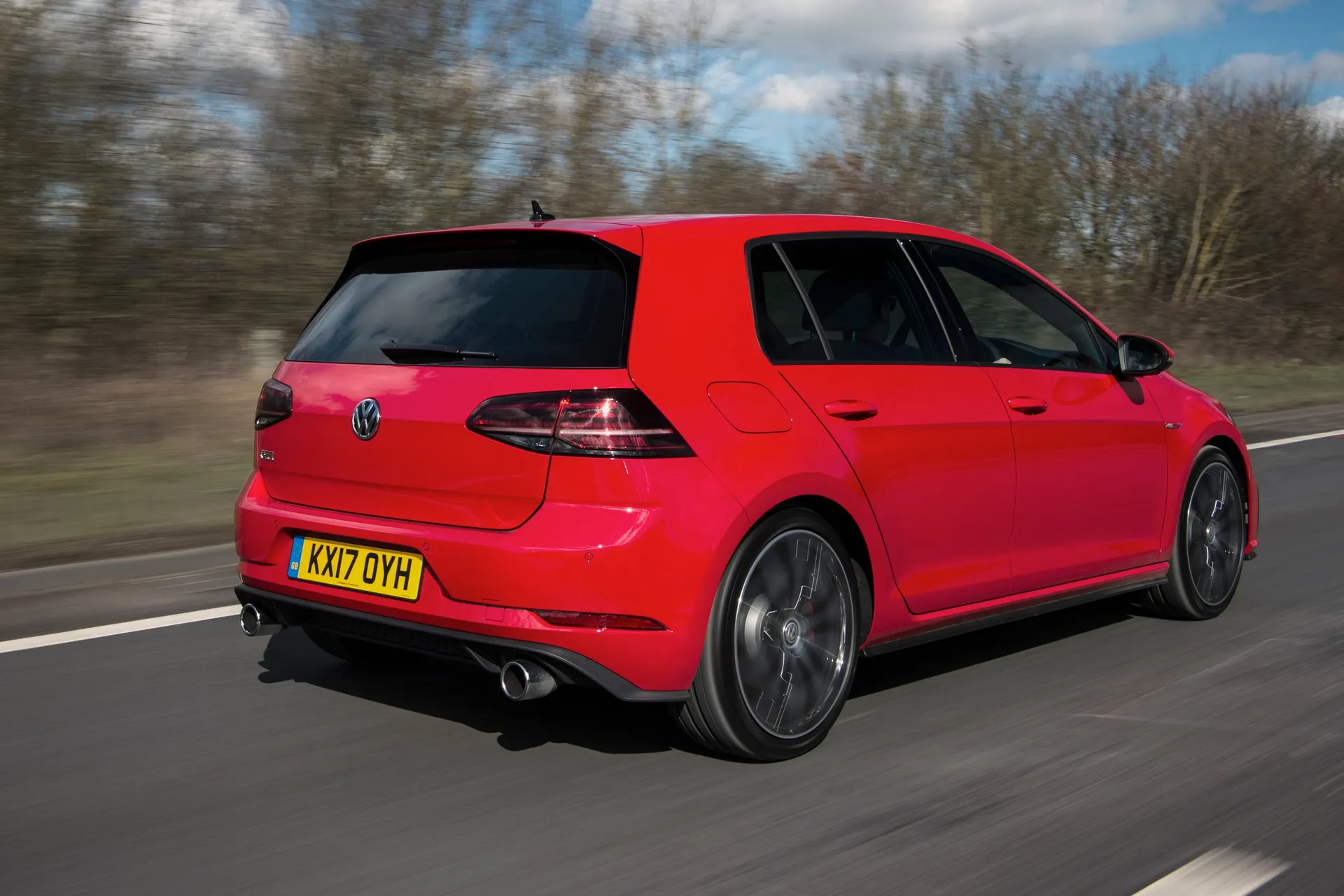
The worry with many front-wheel drive hot hatches is their ability to transfer all their engines’ power to road. Some can struggle but the Golf GTI is so well set-up that you rarely feel it scrabbling for traction, even if you floor it out of a junction.
The best part of the GTI is, without doubt, the ride. It's unbelievably smooth and forgiving for any car, let alone a performance hatch like this. It means you can comfortably live with the GTI day to day and happily take the family out in it. That's not something you can say of all hot hatches, such as the very firmly sprung Honda Civic Type R. The Golf will also happily cruise along the motorway at 70mph feeling as relaxed as a diesel Golf.
Don't think the GTI has gone soft though. It's still sharp in corners with minimal body roll and even when pushed it responds predictably and safely. It certainly inspires confidence from behind the wheel. Elements like the short gear change and precise clutch help, while throttle response is instant. The Driving Mode Selection also helps here with a choice of Normal, Sport, Eco and Individual set-ups for the throttle and steering feel.
Volkswagen introduced a Performance Pack for the GTI early on, which boosts power over the standard version and also comes with uprated brakes and a limited slip front differential.
It's the latter which makes the most difference. It's means traction from low speeds is markedly improved with the front wheels able to transfer power cleanly down without the tyres scrabbling for grip. On the road, you won't notice it that often, but having tested it on a race circuit, we can safely say it works incredibly effectively, especially when using all of the car’s performance.
What engines and gearboxes are available in the Volkswagen Golf GTI?
Every Golf GTI in this Volkswagen’s seventh generation uses a turbocharged 2.0-litre TSI petrol engine. At its launch in 2013, Volkswagen equipped it with 220PS, which even then was at the lower end of the power spectrum for hot hatches. As a result, the Performance model was quickly added with 230PS and also came with improved brakes and a very useful limited slip differential.
Volkswagen later uprated the standard hatch to 230PS and gave the Performance version a boost to 245PS. For the end of production, the Performance was the only base GTI on offer with a DSG seven-speed automatic gearbox. Prior to that, there was also the standard and precise six-speed manual gearbox for the normal and Performance models, while the standard GTI could also be had with a six-speed DSG auto.
There have been two other seventh gen Golf GTIs in the shape of the limited run Clubsport Edition 40 in 2016 to mark four decades of the GTI. It has 265PS with the ability to leap to 290PS for 10-second bursts and could see off 0-62mph in 6.3 seconds.
The other short run GTI is the TCR, or Touring Car Racing, model with a full 290PS on offer all the time. It uses a seven-speed DSG ’box, has its own unique alloy wheels and interior trim, and covers 0-62mph in 5.6 seconds to be quicker over this dash than a Honda Civic Type R.
Refinement and noise levels
If there is one area where the Volkswagen Golf GTI has the measure of all of its rivals, its refinement. Now, while some hot hatch buyers may poo-poo this trait in cars that are supposed to be all about driving pleasure, anyone who has to live with a hot hatch as their only car will soon value the Golf’s gentle approach.
The 2.0-litre turbo petrol engine is quiet at all speeds when you are simply making normal journeys. Push it harder and there is some growl from the exhaust and a little chirp from the turbo, so you still know this is a performance hatch.
However, even on the larger 19-inch alloy wheels of the TCR model, the GTI enjoys very little road rumble inside the cabin. Stick to the normal models with their 18-inch wheels and the GTI is hushed and very easy to use to cover long distances.
The same is true of wind noise as there’s very little to be heard from the interior of the GTI. It means you can hold a conversation between the front and back seat occupants without having to raise voices.
The Golf GTI’s refined credentials are topped off in the way all of the controls work with just the right amount of weight and positive actions. Yes, the clutch and brakes have a slightly weightier feel than a 1.5 TSI version, but it simply serves to remind you that you’re in a hot hatch.
Safety equipment: How safe is the Volkswagen Golf GTI?
When it was tested in 2012, the seventh-generation Volkswagen Golf scored a full five-stars for safety overall. The GTI enjoys the same rating and ranked at 94 per cent for adult occupant safety and 89 per cent for child passenger safety. Even a few years down the line, this Golf is a very safe bet.
The GTI comes with twin front, side and curtain airbags, as well as a driver’s knee ’bag. Every occupant gets a three-point belt and there are Isofix child seat mounts in the two outer rear chairs.
Volkswagen supplies ESC stability and traction control with the Golf GTI. Later models gained Front Assist that comes with radar-controlled distance monitoring and City Emergency Braking to spot hazards and use the brakes if the driver doesn’t react to warnings.
The GTI also comes with Hill Hold to stop the car rolling backwards as you get ready to pull away on an incline. There’s also Adaptive Cruise Control, parking sensors and Lane Assist, as well as Dynamic Light Assist and Traffic Sign Recognition. This is in addition to automatic headlights and wipers also being included in the GTI’s specification.
MPG and fuel costs: What does a Volkswagen Golf GTI cost to run?
"The most economical Volkswagen Golf GTI according to official figures is the early 220PS model that could deliver a claimed 47.1mpg. That seemed optimistic for a hot hatch even then and Real MPG figures show you are likely to realise 36.4mpg in normal mixed driving, which is still very decent for a performance model."
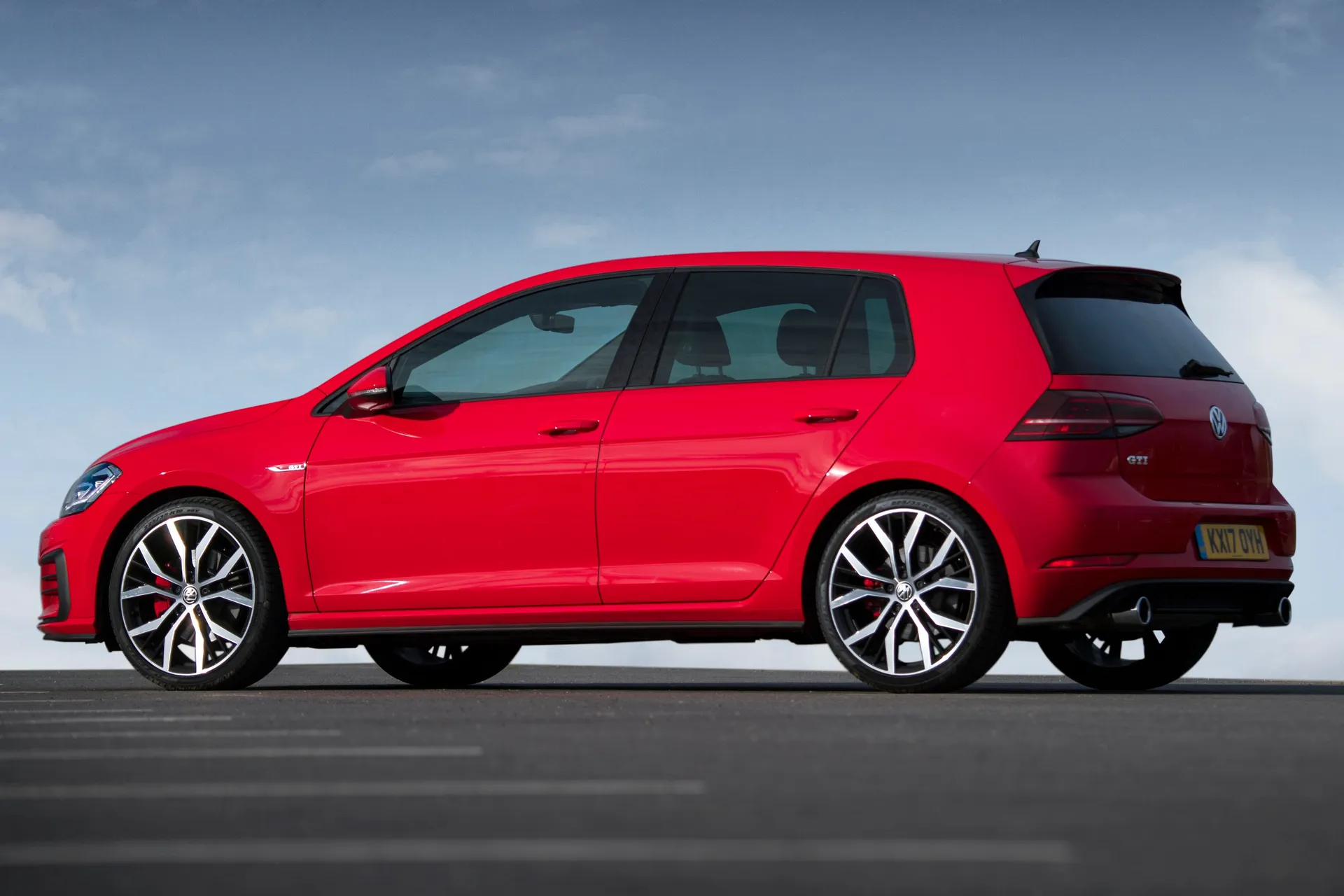
Best of the bunch in Real MPG tests is the 245PS Performance model with manual gearbox that comes in at 37.5mpg compared to a claimed 42.8mpg. On the other hand, the Clubsport is the least frugal with a claimed 40.4mpg and Real MPG number of 29.0mpg.
Insurance groups and costs
Most Volkswagen Golf GTI versions find themselves sitting in group 29 for insurance purposes. That makes them cheaper to insure than most rivals and puts the Golf on a par with the Ford Focus ST for premiums.
The limited edition Clubsport model sits in group 33, while the later GTI TCR is all the way up in group 37, which is only a couple of brackets below the Golf R.
Take the final GTI Performance version of the seventh generation Golf and this 245PS car with seven-speed DSG automatic gearbox sit in group 33 for insurance purposes.
VED car tax: What is the annual road tax on a Volkswagen Golf GTI?
The last of the line Volkswagen Golf GTI Performance model will pay first-year Vehicle Excise Duty of £540 courtesy of its 170g/km carbon dioxide emissions. That’s cheaper than the TCR version which, with CO2 emissions of 175g/km, means the initial 12 months of road tax comes in at £870.
After that, every GTI model registered from 1 April 2017 will pay road tax at £150. Car prior to that will pay the levy at £165 for those in Band F, while the others that fall into Band G will shell out £205 every year.
How much should you be paying for a used Volkswagen Golf GTI?
"Even as the seventh-generation Volkswagen Golf GTI arrived at the end of its lifespan, it was hugely popular. As a result, pre-registered examples of the 245PS Performance model were on offer with only a £500 discount from the original list price."
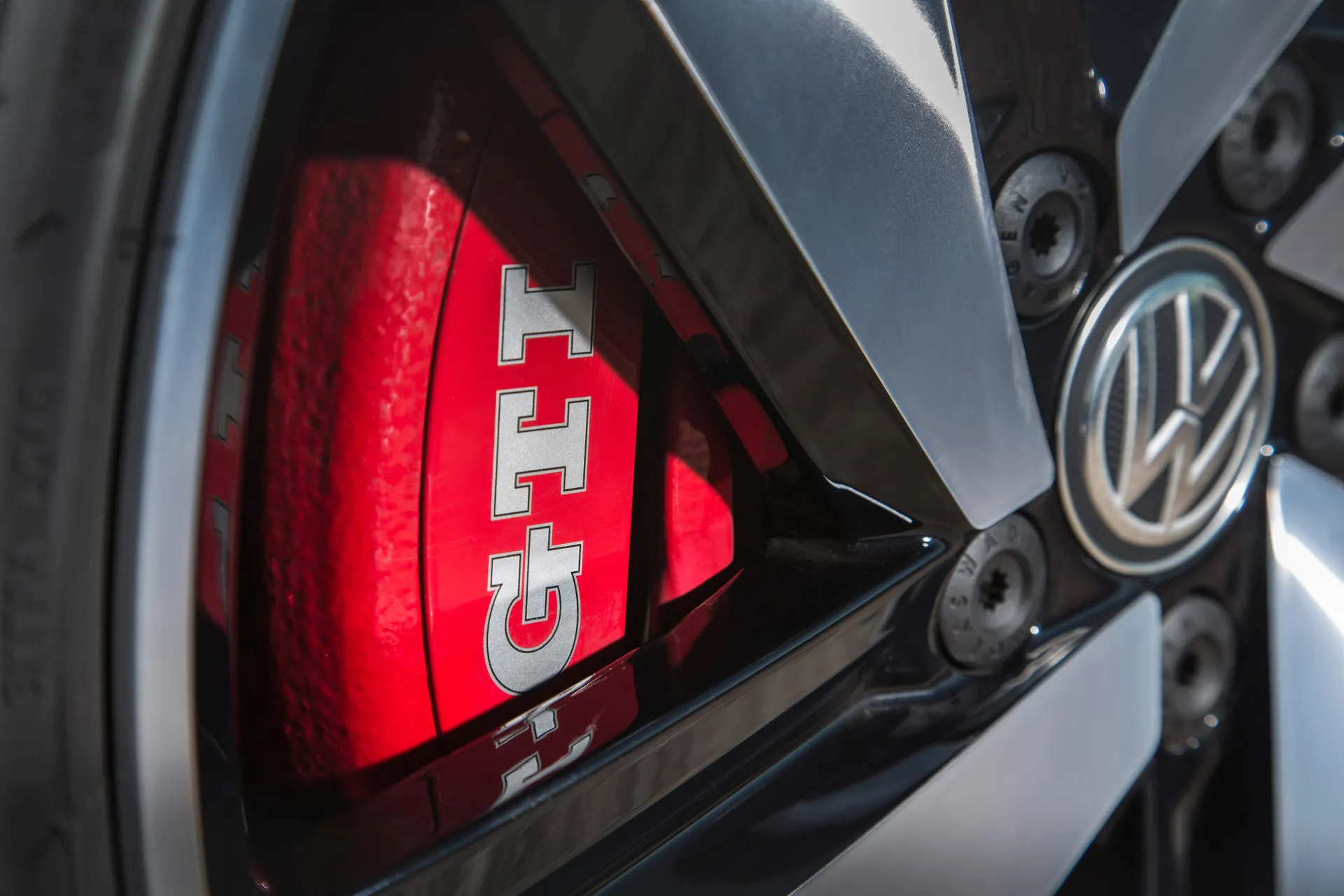
The GTI TCR was harder to find buyers dedicated enough for its more extreme performance, so discounts of £5000 were on offer for this model, so you’d pay £33,000 for one with only 500 miles on the clock.
Look for a three-year old Golf GTI with the 230PS engine and six-speed manual and there are plenty to choose from at the £18,000 mark with 30,000 miles to their credit.
Change that to a seven-year old and you’ll pay around £11,000 for a three- or five-door model with 70,000 miles under its wheels. This will get you a manual or DSG version.
Clubsport models start from £32,000 due to their rarity, while the more prevalent TCR will demand £27,500 for a one-year old model.
Trim levels and standard equipment
The seventh invention of the Volkswagen Golf GTI’s basic trim level didn’t change a great deal throughout its life. So, you get tartan-checked cloth upholstery as standard, with the option to upgrade to leather. There are also heated sports front seats, a flat-bottomed steering wheel, air conditioning, electric windows all-round, 8-inch infotainment screen with sat-nav, and cruise control.
On the outside, the GTI has 18-inch alloy wheels as standard, along with twin exhaust pipes, deeper bumpers and body skirts, plus a rear tailgate spoiler. You also get parking sensors, front foglights and a space saver spare wheel in the boot.
The Performance models gained a little more power, but more importantly came with bigger front brake discs and an electronic limited slip differential. Also, the Performance model from mid-2016 was available with the 12.3-inch Active Info Display in place of the usual analogue main dials.
For the Clubsport version, Volkswagen gave it 265PS along with Launch Control. It also had the option of a black-painted roof, while inside were race-style front bucket seats and less trim as the rear parcel shelf, variable height load floor and carpet mats were all removed to save weight.
The GTI TCR has lowered suspension, microsuede cloth upholstery and sports front seats, as well as red edging for the seats and belts. It sits on unique 18-inch alloy wheels and has a bespoke body kit with front splitter, rear spoiler and diffuser.
Get our latest advice, news and offers
Keep me updated by email with the latest advice, news and offers from heycar.
By submitting you agree to our privacy policy
